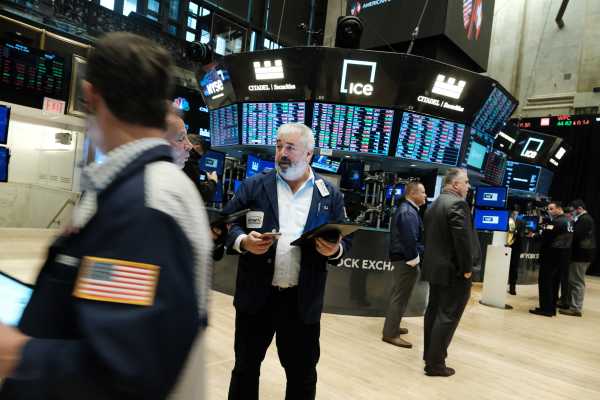
This story is part of a group of stories called

Alas, stocks do not only go up.
The past couple of years have been quite exciting for many investors. After the stock market plunged at the outset of the Covid-19 pandemic, it’s been on a pretty good run. The S&P 500 climbed by 16 percent in 2020 and nearly 27 percent in 2021. Hordes of individual investors rushed into trading, getting into meme stocks like GameStop and AMC and enjoying the perks of a pretty broad-based bull market. Some dipped into cryptocurrencies like bitcoin, which traded above $60,000 per coin for parts of last fall. Tech companies, from Peloton to Netflix to Amazon, felt like pretty sure bets for growth.
The environment made it perhaps a little easy to forget that bull markets don’t last forever, and the waters can get choppy. As the saying goes, markets often take the stairs up and the elevator down, and we’re on the elevator right now.
The S&P 500, Dow Jones Industrial Average, and the Nasdaq are now well below where they were at the start of the year, down 16 percent, 12 percent, and 26 percent, respectively, as of market open on Wednesday. Last week, the Dow and Nasdaq saw their worst single-day declines since 2020. This week, the S&P 500 hit its lowest level in a year. Many names big and small in the tech sector, in particular, have been struggling. Bitcoin, which many proponents have long argued is a form of digital gold that could serve as a hedge for market turmoil, briefly fell below $30,000 more than once this week, less than half of where it peaked at nearly $69,000 in November 2021. The bond market has been hit, too.
Stocks fell late last week and on Monday before offering a modest reprieve on Tuesday. On Wednesday morning, after the release of the latest inflation numbers from the Bureau of Labor Statistics, stocks briefly slid before rebounding. The long and short of it is that markets are bouncy and on edge. Inflation remains near 40-year highs. Investors are anxious about what’s on the horizon and what policymakers are going to do about it.
In the broader recent picture, there really haven’t been many bright spots. Chances are if you look at your investments right now, you maybe aren’t feeling so great.
“In market dislocations, correlations always go to one. Everything moves together,” said Nick Colas, co-founder of DataTrek Research. “There is never a safe haven when the storm is in full force.”
We’re in the midst of quite a storm right now. It’s also one most investors should likely try to weather — stocks don’t go down forever.
“While we are seeing this broad-based sell-off in the market, and it does seem like you cannot avoid it, this isn’t exactly a time for panic,” said Kristin Myers, editor-in-chief of the Balance, a finance website.
There’s a lot to be anxious about on Wall Street and the economy right now
There is never a singular answer for why markets do what they do, why stocks rise and fall, or why investor sentiment changes from one day to the next. With that in mind, maybe the best explanation of what’s going on right now is that there are a lot of reasons for investors to be freaked out, and so they are.
Inflation is a problem in the United States and across the globe, with the US inflation rate near its highest levels in 40 years. In April, the Consumer Price Index, which measures what consumers pay for goods and services, was up 8.3 percent from the previous year and 0.3 percent for the month. The Federal Reserve has begun to raise interest rates and will soon begin to reduce its balance sheet to combat inflation and try to get prices back under control. Those measures may be necessary, but they’re also ones that make Wall Street nervous.
“It always works; that’s the good news. The bad news is it always works because it creates a recession,” Colas said.
Maybe not always. A recession in the near future isn’t a foregone conclusion, but it is likelier than it was, say, a year ago. Analysts at Goldman Sachs estimate there’s a 38 percent chance of the US economy entering a recession in the next 24 months. Deutsche Bank has forecast a recession as well, at first saying it believed it would be “mild” and then becoming a bit more pessimistic.
The Federal Reserve, ideally, would be able to bring down inflation without causing a recession. In early May, Fed Chair Jay Powell declared that inflation is “much too high” and the central bank has a “good chance” of restoring price stability without causing a severe economic downturn. But it’s a tough needle to thread, Kristina Hooper, chief global market strategist at Invesco, said in an email, and the tea leaves are hard to read. “Markets are clearly confused about what the Fed will do this year and just how aggressive it will get,” she said.
There are other uncertainties plaguing investor sentiment concurrently. Russia’s war in Ukraine is ongoing, which could exacerbate inflation, supply chain issues, and oil price fluctuations and contributes to an overall sense of unrest. Slowed growth in China and concerns about the impact of Covid outbreaks there are contributing to anxieties, too.
“There are times in the market when things seem pretty predictable, and the market goes up gradually during those periods because tomorrow looks like today,” Colas said. “Then there are times when things are very uncertain, such as now, and the range of expected outcomes is higher. When that happens, market volatility is always higher.”
Sometimes what goes up is just going to come down a little bit — or a lot
As mentioned at the top, many assets have been up by quite a lot in recent months and years, perhaps to the point that they were trading at more than they should have been.
Sam Stovall, chief investment strategist at CFRA Research, pointed out that coming into the year, some dips in the market were to be expected. As a general rule, what goes up usually comes down for a while, at least a little bit. Every time the S&P has been higher than 20 percent or more over the course of a year since World War II, investors have wound up “digesting” some of those gains early in the new year — in other words, giving some gains back. “Stocks, without question, were expensive,” Stovall said.
The Nasdaq, which follows tech stocks, and the Russell 2000, which is composed of small-cap stocks, have already slipped into bear market territory, meaning they’re 20 percent off of their recent peaks. Stovall warned the S&P 500 might be close behind.
Tech companies, specifically, have been hit hard. For example, the at-home fitness company Peloton — once a pandemic darling — has had major struggles, business-wise. Its market cap, which once peaked at about $50 billion, is now under $5 billion. The stock trading platform Robinhood recently announced layoffs, as did the streaming company Netflix, the stock price of which was hammered in April after it announced it lost subscribers in the first quarter of the year. Uber says it’s cutting costs and slowing hiring, and Facebook parent company Meta plans to slow hiring, too. The stock prices of Amazon, Google parent Alphabet, and Meta are all down more than 20 percent this year.
Higher interest rates tend to negatively affect valuations and stock prices, and they could hit tech particularly hard. “Higher interest rates take a bite out of future profits, and for high-growth stocks, those future profits are everything for them,” Myers said.
As the Wall Street Journal notes, in recent years, tech companies have served as a relatively reliable source of growth. What’s not clear now is whether this is a temporary reshuffling and slowdown or a sign of a broader, more sustained slowdown in what’s been a pretty hot area. Maybe there was too much excitement around some of these companies in the first place.
“Tech companies, many of them, especially consumer product companies got over-valued on the venture side, and many of those companies that have since [gone public], if you will, have mostly lost their valuations,” said Arjun Kapur, a venture capitalist focused on internet and consumer tech.
The crypto industry has not been immune from market moves, either — a sign that it’s not as insulated from the market as some of its investors would like to believe. “The people who own crypto tend to own stocks, and that means that even if the asset class is fundamentally unlinked to stocks, it is still linked through investor confidence in the future,” Colas said.
“Most asset classes other than cash are coming under pressure,” Hooper said. “This includes crypto.”
As life gets back to a more normal state compared to where it was at other points in the pandemic, some of the trends that made certain companies attractive are reversing. People are going back to life in the real world and relying a little less on the internet for every part of their lives.
‘We have to kind of understand that we as a society, as a world, as an economy, as a stock market, we’re still in the early stages of coming out from the zombie apocalypse and the shutdown and the pandemic,” said Brian Belski, chief investment strategist at BMO Capital Markets. “We’re still living by different rules, and we’re trying to unwind those different rules as we inch toward this transitioning of normalcy.”
Things might be bad for a while, but they’re probably not going to be bad forever
In moments like this, where all the CNBC chyrons are red and all the headlines are talking about market meltdowns, it’s natural to feel panicky about the financial future. Vox is not in the business of giving investment advice, but just in terms of some life advice, the best is probably this: Do not panic.
Over time, historically, the stock market has gone up, and almost any expert out there will tell you that’s what’s going to eventually happen. Think back to how nervous a lot of people felt about the markets in February and March 2020 when they were in free fall and about what happened after that.
If you’re young and have the stomach for it, this might not be a bad time to buy, Myers said, namely if there are stocks or assets you’ve had an eye on that are now trading lower than they have in the past. “Think of this as everything is on sale,” she said.
While you often hear that this kind of moment is not a great time to check in on your 401(k), it might not be a bad reminder that you should be checking in on it more often. Myers suggests once a quarter as a good rule of thumb, just to see what’s going on and reevaluate. “It doesn’t mean that you need to make a lot of changes, but maybe it’s time for you to move around your assets a little bit,” she said. Moving assets around does not translate to cashing out.
If you’re closer to retirement, hopefully your portfolio has already been rotating away from riskier investments, such as stocks, and into something less volatile. If that hasn’t been happening, now might be a good time to think about doing that.
Bigger picture: Ideally, investing is a long game that you should be able to win.
“I think investors need to remind themselves that market declines are pretty common,” Stovall said. That doesn’t mean that, over time, markets won’t recover. “If investing is gambling, I would love to know what casino pays the gambler 80 percent of the time. In 80 percent of all years since World War II, the S&P 500 has posted a positive 12-month total return.”
Update, May, 11, 2022, 10:30 am: This story has been updated to reflect the Bureau of Labor Statistics’ most recent Consumer Price Index report.
Will you support Vox’s explanatory journalism?
Millions turn to Vox to understand what’s happening in the news. Our mission has never been more vital than it is in this moment: to empower through understanding. Financial contributions from our readers are a critical part of supporting our resource-intensive work and help us keep our journalism free for all. Please consider making a contribution to Vox today.
Sourse: vox.com






